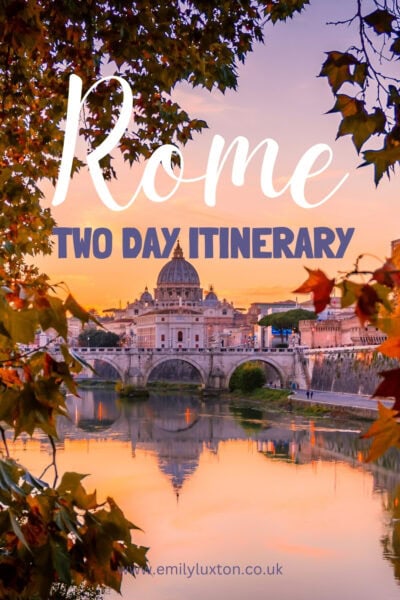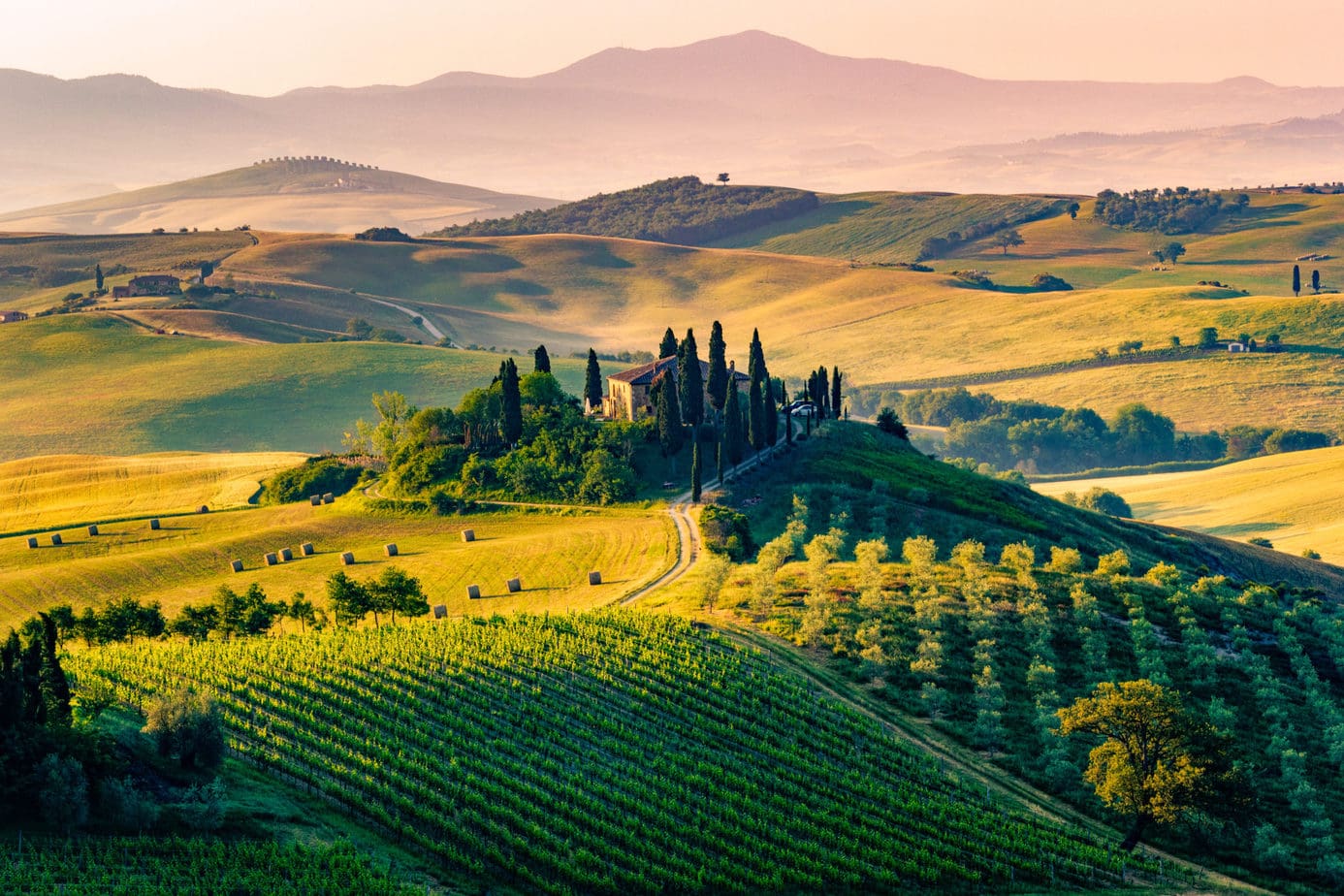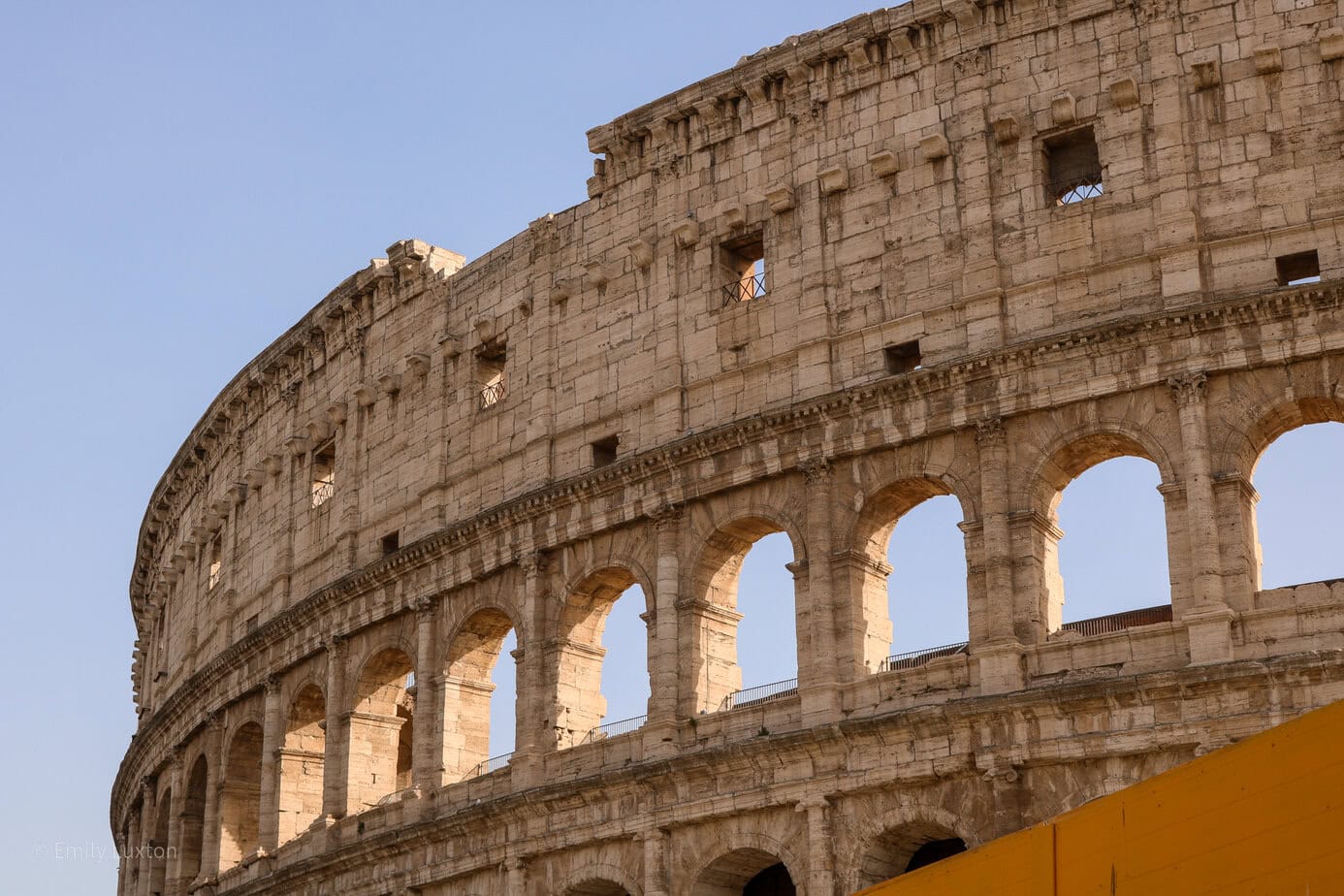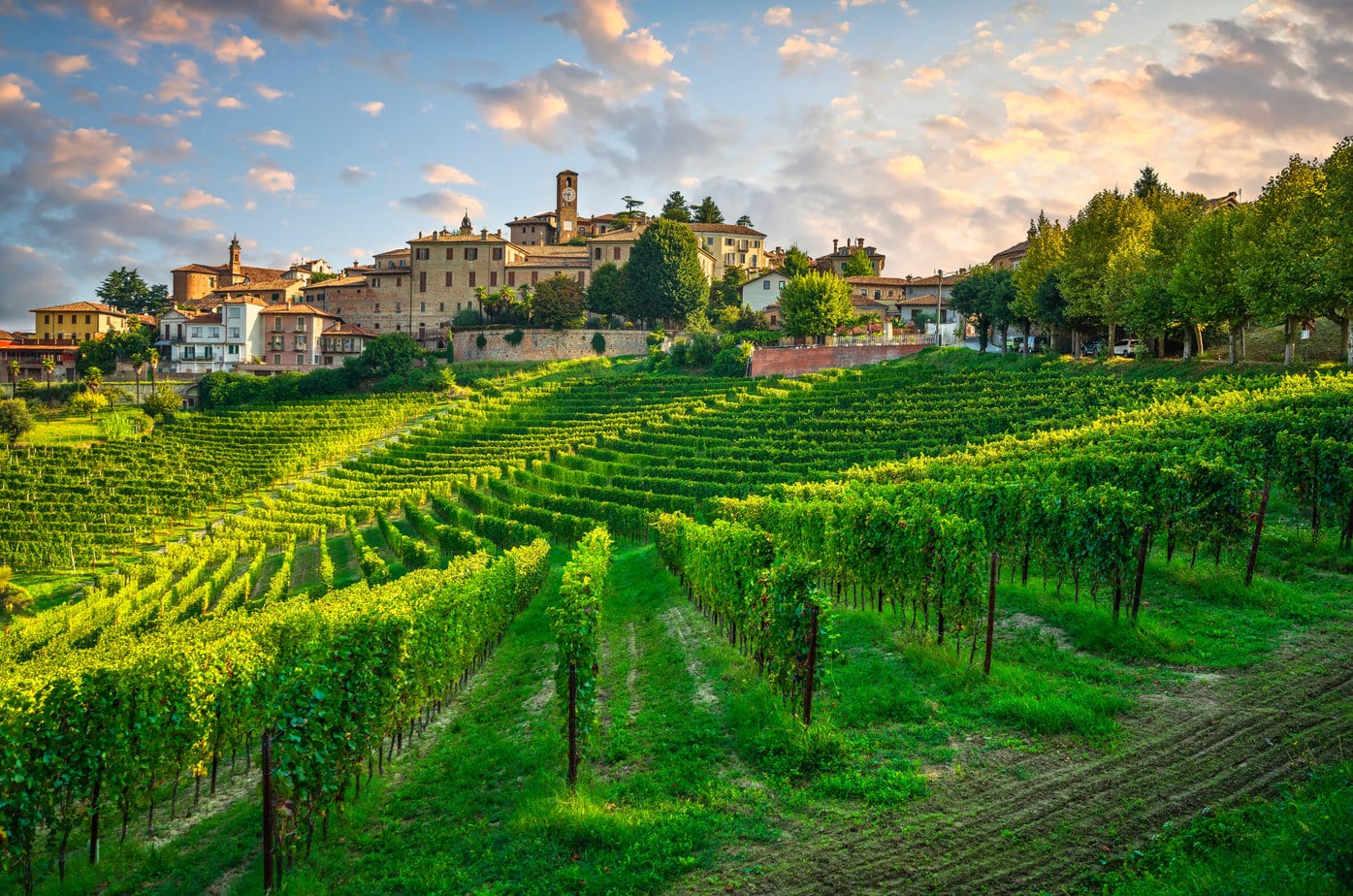Some posts on this site contain affiliate links. If you book or buy something through these links, I earn a small commission (at no extra cost to you). Take a look at my privacy policy for more information.
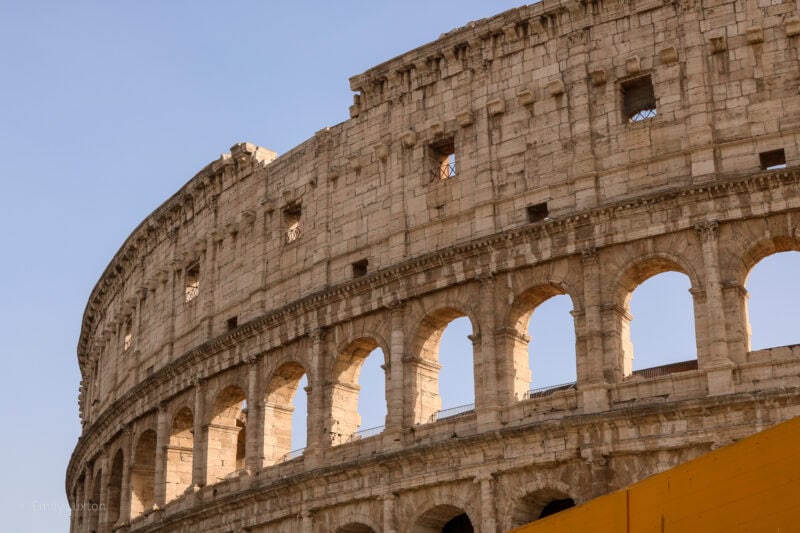
An honest, realistic guide & itinerary to help you plan your 2 days in Rome – without trying to fit too much in!
As the classic cliche goes, Rome wasn’t built in a day – and you’ll need at least two days to see it all. More, really.
To get the most out of your city break, aim for three nights and two full days. If you only have two nights, you might have to shift the below itinerary around a little – but you can still cover most of the big sights.
If you’re short on time and need quick answers, I’ve got a short version of the entire itinerary (plus a map) at the very bottom of the page. Use the contents menu below or scroll right down to find it. Otherwise, keep reading for my detailed itinerary and guide to planning your two days in Rome. Enjoy!
My recent visit to Rome was sponsored by hu Roma camping in town (more on that in the “Where to Stay” section). All words and opinions are my own.
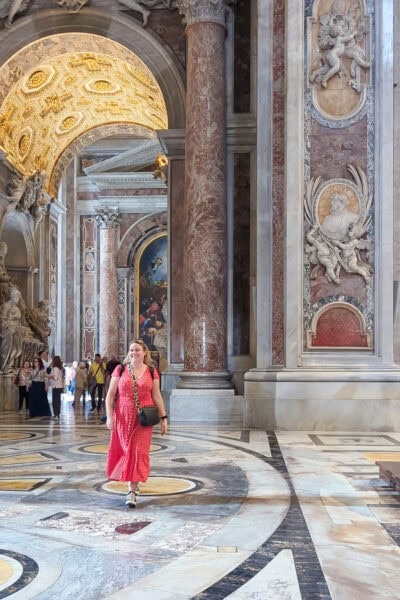
Is a 2-Day Trip Long Enough for Rome?
My honest answer to this is no! Rome is a fantastic city and there’s SO much to see and do here. Plus, in a city that’s known for its amazing cuisine, wonderful nightlife, and fabulous shopping scene, a longer visit allows more time to wander and soak up that famous “dolce vita”.
But sometimes, two days is all you have! And if you only have time for a whirlwind visit to Rome, the good news is that you can pack a lot into two days.
My most recent trip to the city was almost exactly 48 hours. In that time, I was able to visit the Vatican, soak up the art at the Borghese Gallery, take an open-top bus tour, wander some pretty sidestreets, and cram a LOT of pasta into my face!
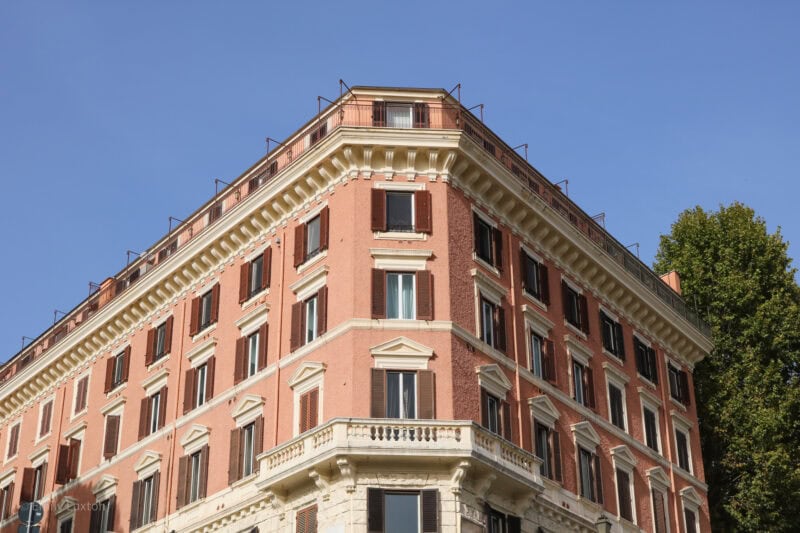
Top Sights for Your First Trip to Rome
I’ll kick off with a quick list of all the “main” sights in Rome – perfect if you only have a couple of days to explore.
- The Colosseum & Roman Forum
- Borghese Gallery
- Vatican City (including the Sistine Chapel and St Peter’s Basilica)
- Trevi Fountain
- Pantheon
- Spanish Steps
Note: The last three sights are all located fairly near each other in the Centro Storico
Two Days in Rome: Itinerary
In a hurry? There’s a map and a quick version of this itinerary at the very bottom of the page. Otherwise, here’s my itinerary to help you see as much of Rome as possible in 2 days…
Day One in Rome
1. The Colosseum & the Roman Forum
How much time: 1-2 hours (2.5-3 hours if you include the Roman Forum)
The Colosseo (Colosseum) is probably Rome’s most famous attraction. Almost 2,000 years old, and the largest ancient amphitheatre ever built, the stadium once seated around 50,000 spectators and is truly breathtaking to behold.
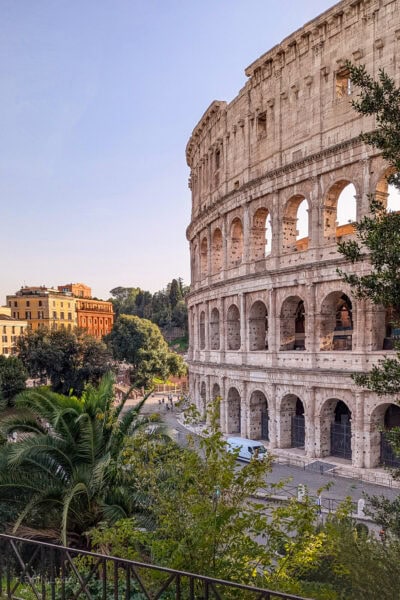
As the city’s most iconic sight, it’s usually very packed and can have long lines – so I recommend heading here as early as possible. Tickets also include entry to the nearby Roman Forum; an impressive expanse of ruined streets and buildings which were once the very heart of Ancient Rome.
Pre-book your tickets (ideally for the first timeslot of the day) from the official site, or book a guided tour for skip-the-line entry and some interesting history with an expert. This 1-hour Guided Tour is ideal for anyone on a tight schedule.
Very short on time? Skip the Roman Forum and only visit the Colosseum. If you’re really pressed, you could skip the visit altogether and simply walk around the outside of the Colosseum, which would take around 10-30 minutes.
RECOMMENDED TOUR: Priority Access Colosseum, Roman Forum & Palatine Tour, 2.5 hours, from €62.40pp
2. Hop-Hop, Hop-Off Bus Tour
How much time: At least 2 hours
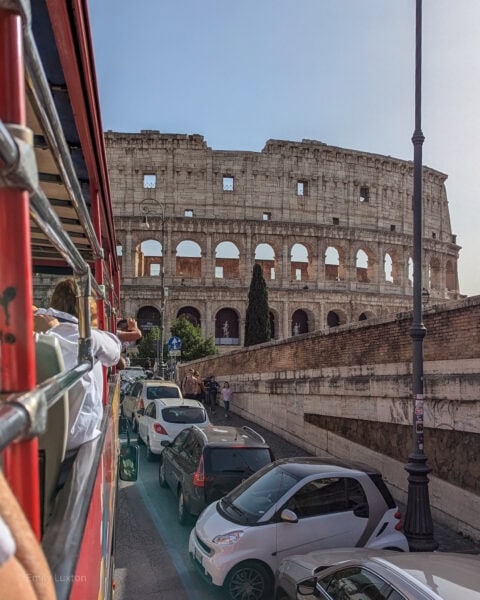
If you’re on a tight schedule, the hop-on-hop-off bus tour from City Sightseeing is a great way to see a lot of Rome in a short space of time. It’s also much less tiring – and includes a free audio guide to share some background on the things you’re looking at.
There’s a bus stop at the Colosseum, so you can hop aboard once you’re done exploring (or use the bus to get there). Riding the complete circuit without getting off takes around 2 hours. If you do hop off, there are buses every 15-20 minutes.
Top tip: The right-hand side of the bus has the best views of the Colosseum as you approach.
3. Tour the Borghese Gallery
How much time: 1-2 hours (visits are timed and last 2 hours max).
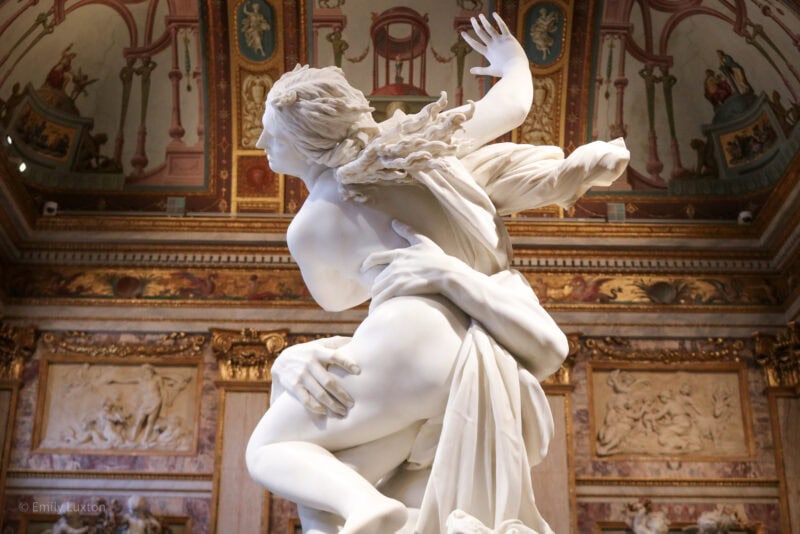
Next, head to Galleria Borghese to soak up Rome’s incredible art history. If you’re riding the City Sightseeing bus tour, you can hop off at the Piazza di Spagna and walk up – otherwise, it’s about a 50-minute walk.
The gallery is housed within the historic Villa Borghese Pinciana, set within a lovely park. Allow some time to explore the surrounding gardens – you can even rent a rowboat on the lake!
The architecture and decor are stunning, but the real treasure inside the villa is the art collection. Highlights include marble statues by the famous Bernini and paintings by the masterful Caravaggio.
I recommend you pre-book your tickets as far in advance as possible (this is the official website – tickets are €13 + a €2 booking fee). You can also pay a bit extra for Skip-the-Line Tickets (from €40, a host will meet you and escort you through the entrance). However, guided tours cost about the same amount and also allow you to skip the line, so these are usually better value.
RECOMMENDED TOUR: Borghese Gallery Small Group Guided Tour (includes skip-the-line entry tickets) from €40
Evening: Take a Food Tour
How much time: 2.5 hours

If you’ve still got some energy left, I highly recommend taking a food tour of Rome. It’s such a fun way to discover the city and its incredible food scene.
I booked this 2.5-hour street food tour through Get Your Guide (from €40pp) on my first trip to the city. I wasn’t disappointed: the tour was great, our guide Graziella was amazing, and I ate a LOT!
Alternative tour: 4-Hour Food Tour by Night with over 20 food tastings – from €109pp.
Day Two in Rome
1. Visit the Vatican
How much time: 2.5-3 hours (at least)
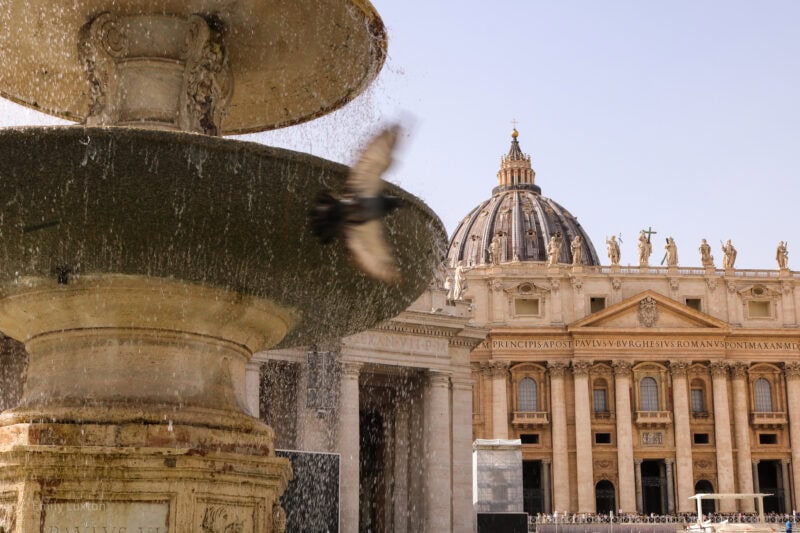
Vatican City is a must-visit in Rome. Not only is this city-state the headquarters of the Roman Catholic Church and home of the Pope, but it also houses a huge collection of art, architecture and artefacts.
There are ancient Roman sculptures, Renaissance frescos, masterwork paintings, and – of course – the famous Sistine Chapel ceiling, painted by Michelangelo.
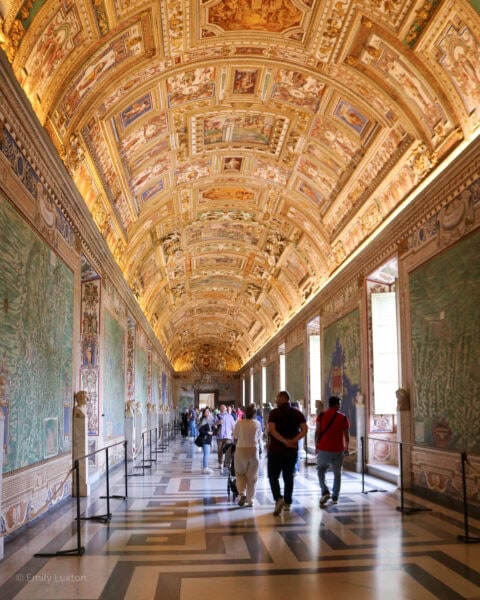
I highly recommend taking a guided tour at the Vatican. The entry lines can be insanely long (I met people who’d been queuing for three hours) and it gets very busy inside. A tour will allow you to skip the line, and can help you navigate the crowds – plus I don’t think I’d have had a clue what I was looking at without a guide! You can pre-book Skip The Line Tickets (click here), but this just means skipping the queue to buy tickets – you’ll still have to queue to get in.
Recommended tour: Vatican Museums, Sistine Chapel, and Basilica Tour, from €95pp
Top Tip: 2025 is a Jubilee year at the Vatican, which happens every 25 years. It’s a big deal, and visitor numbers are expected to surge. Pre-book your tickets as far in advance as you can.
2. Walk along the River to Castel Sant’Angelo
How much time: 20-minute walk + 5-minute photo stop
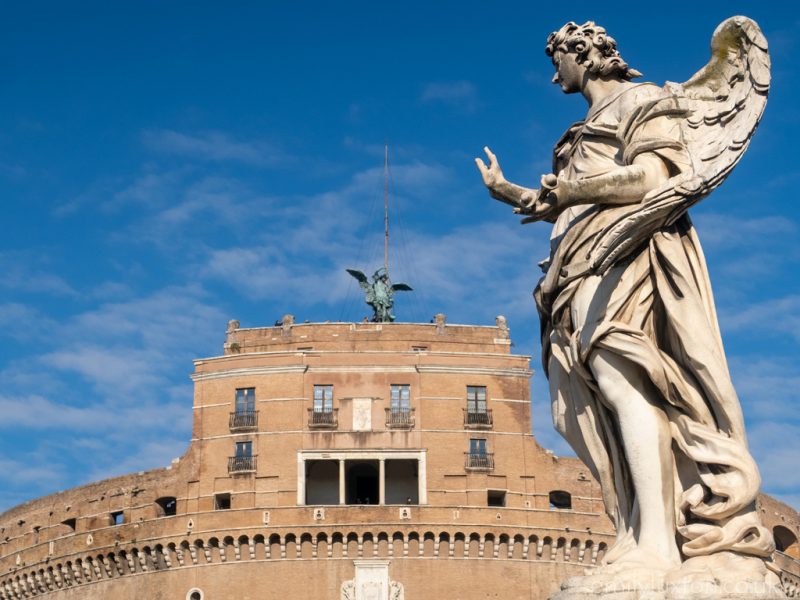
When you’re done exploring the Vatican, it’s only a short stroll to the nearby Castel Sant’Angelo – an iconic sight in Rome, best viewed from the ancient Ponte Sant’Angelo bridge.
Originally built as a mausoleum for the Roman Emporer Hadrian (of Hadrian’s Wall fame!) and later used as a fortress, today, the castle is a museum. There are some lovely frescoes, beautifully decorated rooms, and a collection of weapons – but on a short trip to Rome, it’s not really worth going inside.
Detour: If you have time, I highly recommend a detour to the nearby Neve di Latte gelato shop, which was one of my favourite discoveries! Read more in my Rome gelato guide!
3. Centro Storico Walking Tour: Pantheon, Trevi Fountain and Spanish Steps
How much time: 1 hour (at least)
Rome’s Centro Storico (Historic Centre) is the heart and soul of the city: a dazzling neighbourhood of pretty piazzas, cobbled alleyways, ancient architecture, ornate palaces, and historic churches.
You could spend hours (days, even) getting lost in its scenic side streets. But we’re on a tight schedule! Thankfully, the three main sights form an easy walking tour that will take around an hour (allowing for stopping time):
Walking Tour Route
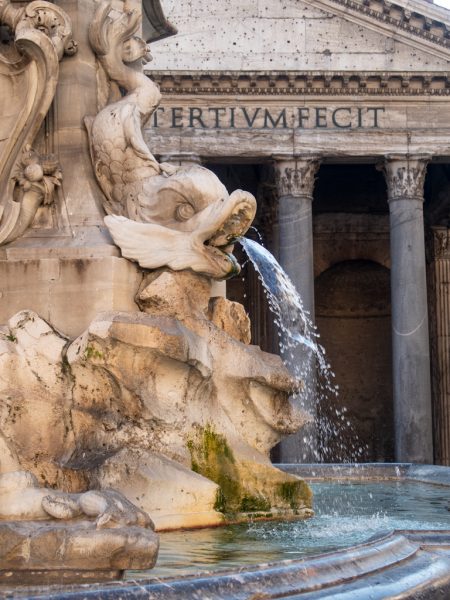
1: Pantheon (15-minute walk from Castel Sant’Angelo). A Roman temple dating from around 126AD which was later turned into a Catholic Church. The facade is particularly impressive and there’s a very pretty piazza outside with a beautiful fountain.
Top tip: It’s worth going inside the Pantheon (€5, pre-booking not necessary) to admire the spectacular domed ceiling – and to see the tombs of the painter Raphael and the Sardinian King Vittorio Emanuele.
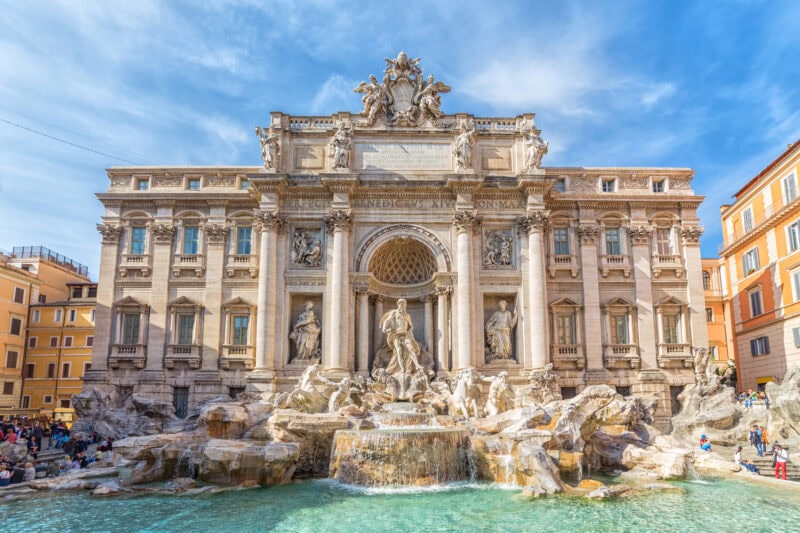
2: Trevi Fountain (10-minute walk from the Pantheon). Be prepared for crowds at Rome’s most photographed fountain! Made famous by the classic 1960 film La Dolce Vita, the fountain was built between 1732 and 1762 and features an impressive facade with numerous sculptures and icons.
Top Tip: Come back in the evening and you’ll hopefully find the fountain less crowded.
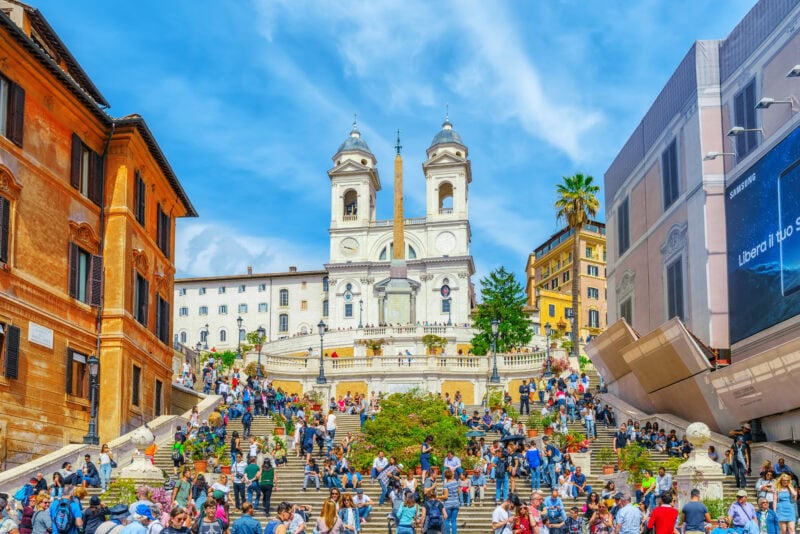
3: Spanish Steps (10-minute walk from the Trevi Fountain). This grand, historic staircase dating from the 1720s leads from the Piazza di Spagna to the white, twin-towered Trinità dei Monti church. It’s another Rome icon and a popular photo spot, but again, be prepared to share it with crowds!
Detour: Swing by the Don Nino gelato shop near the Pantheon to try what might be the best gelato in Rome.
Where to Stay in Rome
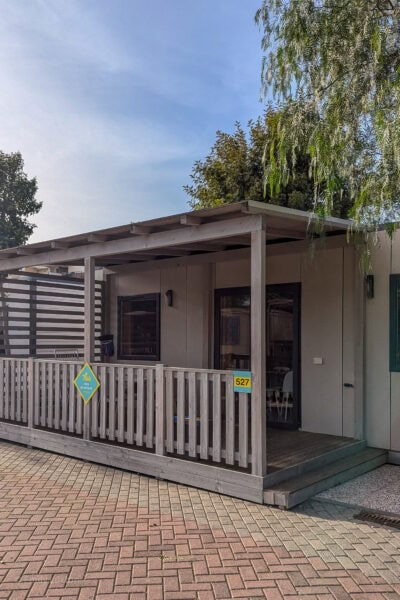
If you’re looking for a great, affordable place to stay in Rome, I can highly recommend hu Roma camping in town. Part of the hu openair group, this is a peaceful, leafy camping village on the very edge of the city.
It’s like a mini holiday park – affording the perfect escape after a busy day exploring Rome. You get the best of both worlds here: all the action of the city centre, plus the chilled-out vibes and self-catering affordability of a holiday park.
PROMO CODE: Use my exclusive reader promo code EMILYFORHU for a 10% discount valid on villages and campings in town for stays until 17/04/2025 (including Christmas holidays).
hu Stay Premium Mobile Home
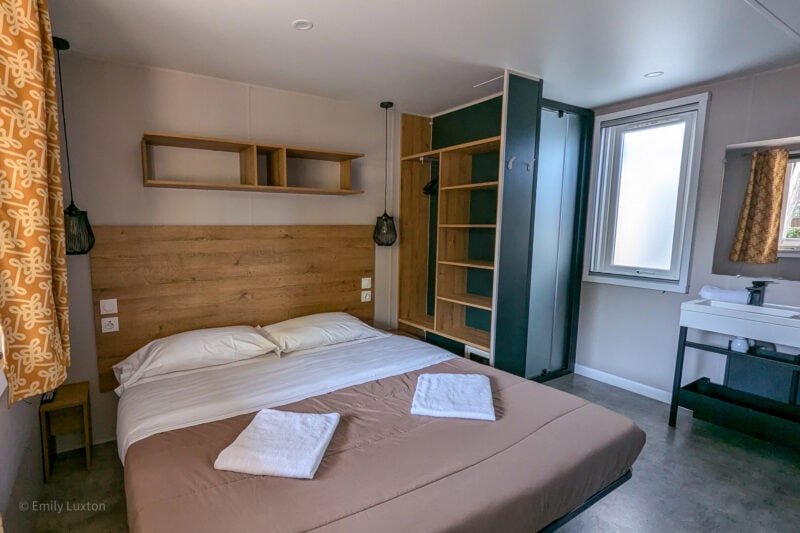
I stayed in one of the hu Stay Premium mobile homes. It sleeps five guests across two rooms: a double and a triple with a bunk bed. Both rooms have their own ensuite toilet and shower. Between the two bedrooms is a roomy kitchen/dining room. Click here to watch my video walk-through.
The best part is the large veranda out the front of the property, with a large table for outdoor dining or evening drinks.
From the outside, it looks like a very small unit – but it’s actually surprisingly spacious. There’s loads of storage space, both bedrooms are very large, and the kitchenette comes with a full-size fridge and lots of cupboards.
hu Roma camping in town
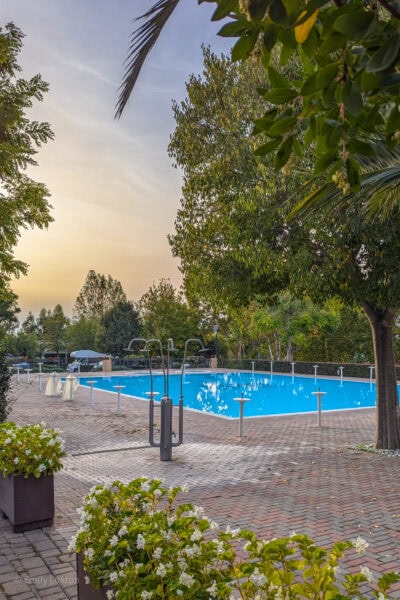
There are camping and motorhome pitches, so this is the perfect place to stay if you’re taking a road trip in Italy. If not, there are also mobile home units like the one I stayed in: ideal for a self-catering getaway.
Although hu Roma camping in town is ideal for families, it didn’t feel overly family-focused or exclusively geared towards young kids. In fact, I’d say about 50% of the other guests were couples or groups of adults.
There’s an outdoor pool with two jacuzzis, a large BBQ area, a small playpark, a basketball & football court, table tennis tables, and a very well-stocked mini market for grabbing the essentials.
There’s also a great bar (perfect for a sunset Aperol Spritz!) and a lovely onsite restaurant serving delicious Italian dishes at pretty reasonable prices. Pasta dishes were around €13 – and both meals I had at Rione were excellent. I highly recommend the tiramisu!
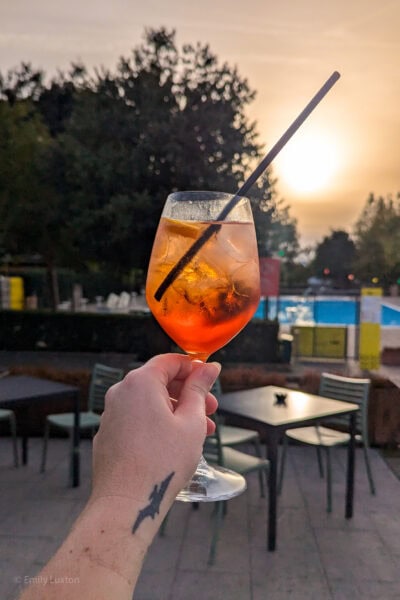
The only downside is that you’re a little far from the city centre. It’s about 5km to The Vatican, but the traffic can be pretty bad, which slows the journey down. Taxis aren’t too bad: I paid €18 coming back from the Vatican, and about €35 coming back from Villa Borghese (the far side of Rome).
Thankfully, hu Roma camping in town runs a shuttle bus (€5 return) to the Cipro metro station – where you can walk to the Vatican or hop on the metro to explore further. You can also take public buses, which stop right outside the park’s entrance, to reach the nearest metro station.
PROMO CODE: Use my exclusive reader promo code EMILYFORHU for a 10% discount valid on villages and campings in town for stays until 17.04.2025 (including Christmas holidays).
Tips for Making the Most of Your Two Days in Rome
Pre-book or arrive early.
Pre-book tickets (or tours) for the big-hitter attractions, especially if you’re visiting in peak season. Queues can get VERY long and you don’t want to waste hours standing in line when you only have a couple of days to play with.
Some attractions sell “Skip the Line” tickets which are handy for avoiding the longest queues.
If you haven’t pre-booked, arrive as early as you can at the Vatican and the Colosseum. You want to be there before opening time so you can be first in line for entry.
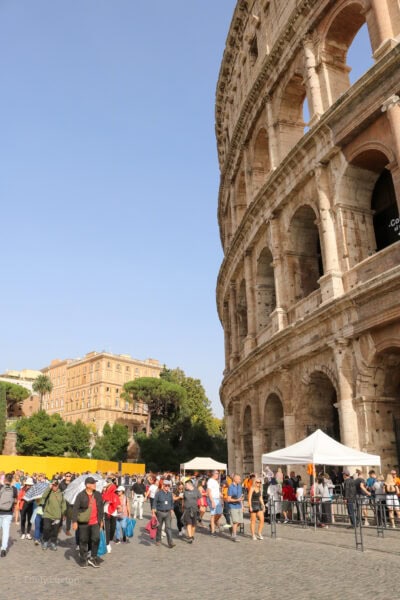
When to go
Alternatively, visit during the off-season. My first trip to Rome was in January and the crowds and queues at all the attractions were significantly less than during summer. I was able to get same-day tickets for the Colosseum with zero wait time.
If you can, plan to visit mid-week rather than at a weekend. During the week, attractions are likely to be a tad quieter than at the weekend.
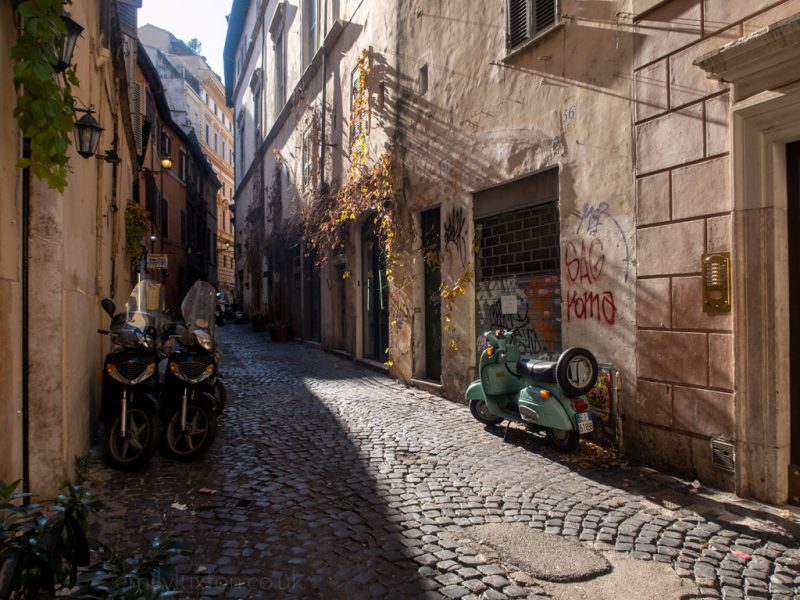
Getting Around
Rome’s Centro Storico is fairly compact and walkable, but the rest of Rome’s city centre is sprawling. If you’re short on time, it can be tempting to use taxis to get around – but this can add up fast.
Thankfully, there’s a pretty decent public transport system in place. There are three metro lines in the city: lines A (the red line) and B (the blue line) cover the city centre and some of the most famous monuments, like the Colosseum, the Spanish Steps, and the Vatican.
Trains are very frequent and the map is fairly easy to figure out. Also, the ticket machines can be switched to English. You can buy a single journey ticket (100 minutes) for €2, or there are day and week-long tickets. Click here for an in-depth guide to using the metro.
If you do need to take a taxi, I recommend using FREE NOW; a ridesharing app similar to Uber but more prevalent in Italy.
What and where to eat
One of the best things about visiting Rome is the FOOD. I could quite happily spend two days in the city without visiting any attractions, just eating pasta and gelato!
I’ve got a separate post about the top local dishes to try in Rome: click here to check it out. Below is a quick list of some of the best restaurants – all of which are close to the sights on the itinerary above:
- Supplizio – A great place to try suppli (traditional Roman street food snack)
- Panificio Bonci – Good for a quick lunch near the Vatican. Order the porchetta sandwich!
- Pizzarium by Gabrielle Bonci – Pizza by the slice, also near the Vatican
- Settimo – Top floor of the Sofitel with gorgeous views. Good for sunset drinks.
- Da Sergio – Rustic little trattoria with red-checked tablecloths.
- La Matriciana – Try the signature dish, Bucatini Amatriciana.
- Roscioli – Possibly the best carbonara in Rome. You need to book a table as it gets busy – if you’re dining solo, sit at the bar.
Rome 2-Day Itinerary: Map & Quick Version
Day 1
- Visit the Colosseum (allow 1-2 hours minimum)
- Pre-book tickets (preferably the first slot of the day) or book a guided tour.
- Visit the Roman Forum (included with your entry ticket) if you have time.
- Hop-On-Hop-Off Bus Tour with City Sightseeing (allow 2 hours)
- Visit the Borghese Gallery (visits are timed so you can’t stay longer than 2 hours)
- You can use the Hop-On-Hop-Off Bus Tour to get there.
- Prebook your tickets to guarantee entry.
- Afterwards, spend some time exploring the surrounding gardens. You can even rent a rowboat on the lake if you want!
- Evening: Take a food tour (if you still have energy!)
Day 2
- Morning visit to the Vatican (allow at least 2.5 hours)
- I highly recommend booking a guided tour to avoid the queues.
- Don’t miss the Sistine Chapel (look up!), the iconic St Peter’s Basilica, or the stunning Gallery of Maps.
- If you have time – climb the dome of St Peter’s Basilica.
- Walk along the river to Castel Sant’Angelo (it’s about a 20-minute walk)
- You can visit inside if you have time.
- Explore the Centro Storico (allow at least 1 hour, longer if you don’t want to rush)
- The Pantheon (15 minute walk from Castel Sant’Angelo)
- Trevi Fountain (10 minute walk from the Pantheon)
- Spanish Steps (10 minute walk from the Trevi Fountain)
- Allow time to explore the various piazzas and scenic side streets.
- Grab a gelato – I recommend Venchi, Gunther or Don Nino. Check out my guide for more recommendations!
Read More
Why You Should Visit Rome in January
Is Rome Safe for Solo Female Travellers?
14 Dishes You Have to Try in Rome
So, that’s my guide to spending two days in Rome – without exhausting yourself! Got a question? Scroll down to ask in the comments!
